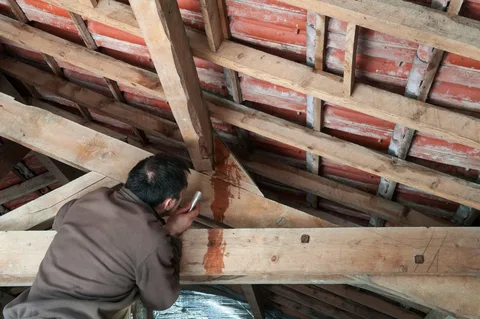How to Locate and Repair a Roof Leak
Two crucial fundamentals for successful leak repair.
First and foremost is the ability to ‘look,’ which may sound simple, and it is, but it takes some practice to do it effectively. What do I mean by ‘look’? Just that—don’t do anything else. Don’t think. Don’t move things. Don’t throw water around; just look. Don’t have a preconceived idea of what is causing the leak.
Take a few minutes and simply observe the roof and the area where the leak is occurring.
Look at where the leak is coming through, and then examine the roof. In 90% of cases, roof leaks are within 1 square meter of where the leak manifests on the ceiling. If your ceiling is on a slope, the leak might often be higher up.
Something should suddenly occur to you as the most likely cause of the water leak.
If, after a few minutes of dedicated observation (and you really have to discipline yourself here—no doing anything else!), you still have no idea where the water is coming from, you need to gather more information.
Find out how long this leak has been occurring, whether it happens in light rain, heavy rain, or during prolonged periods of rain. Does it occur in all types of rain? Or does it only happen when it is windy, and if so, which direction is the wind coming from?
Now, go back to the roof and ‘look’ again. Just look. If you still have no idea after a few more minutes, you’ll need to ‘look’ a bit further. Here are some suggestions:
- “Simulate rain by pouring water on various sections of the roof and observe the flow or accumulation. Envision a torrent of water following the same path…
- Raise a roof sheet or lift a few tiles to inspect for water marks or signs of water inside the roof.”
- Access the interior of the roof (if feasible) and, using a bright torch, ‘look’ for evidence of where the water has been infiltrating.
By now, you should have generated a few ideas. What you ideally want is a ‘Eureka, I’ve found it!’ moment. If there’s a lot of uncertainty in your mind, you likely haven’t pinpointed the issue yet. Continue looking. Return to the roof, change your position, and just observe.
If you haven’t identified the source by now, this is where a bit more technical knowledge comes into play. To excel in finding leaks, it’s crucial to understand the ideal scenario, how the roof should appear, and essentially, the Australian Standards for that type of roofing, along with the manufacturer’s guidelines for their product.
Knowing these details enables you to recognize what seems out of place when you ‘look’ at the roof. Understanding the Ideal Scene constitutes the second fundamental. This expertise typically develops through years of experience and proper training.
However, it’s common to encounter more than one violation of Australian Standards or Manufacturer’s guidelines. This doesn’t always simplify the process, which is why ‘look’ remains the primary fundamental.
One additional thing to be cautious of is the supposed roof leak that might not be a roof leak, such as when someone reports a puddle on the floor without any stain on the ceiling. Be skeptical of such cases!
Another issue that might resemble a roof leak (but isn’t) is condensation. Condensation can lead to spotty mold and eventually a fully blackened ceiling. I always consider the possibility of condensation when I observe mold around a window or over a relatively large area, rather than immediately assuming it’s a roof leak.
The rooms most susceptible to condensation are obviously bathrooms or laundries with a lot of steam. Additionally, well-used kitchens with inadequate ventilation can be problematic. Rooms with a high occupancy or individuals who “live in their room,” as well as rooms with heaters and poor ventilation, can all have condensation problems. South-facing rooms or rooms that don’t get any sun also have trouble drying out and are prone to mold. The clue to condensation is the pattern of the mold, or if mold has not yet formed, what is the pattern of the water marks (which could be very faint). Usually, a roof leak will only manifest in one, maybe two places (unless it is really bad — but then it is obvious you have a roof leak!). Mold due to non-roof leak sources will form over a wider area, not necessarily the whole ceiling or wall though, although it can.

